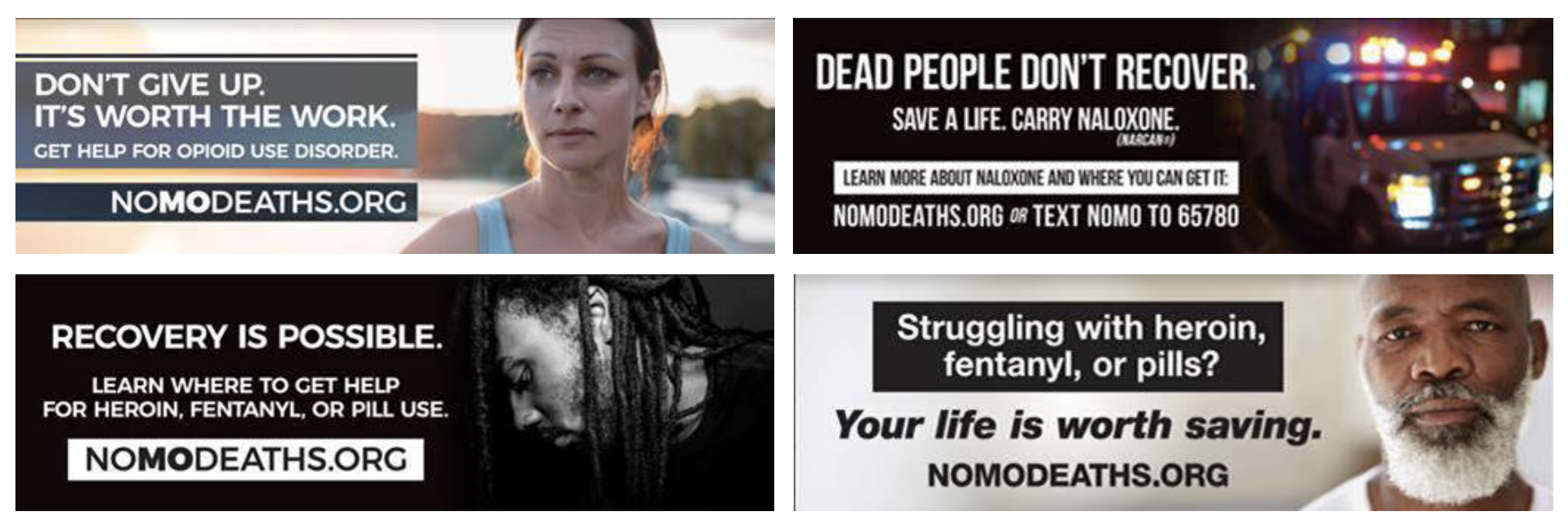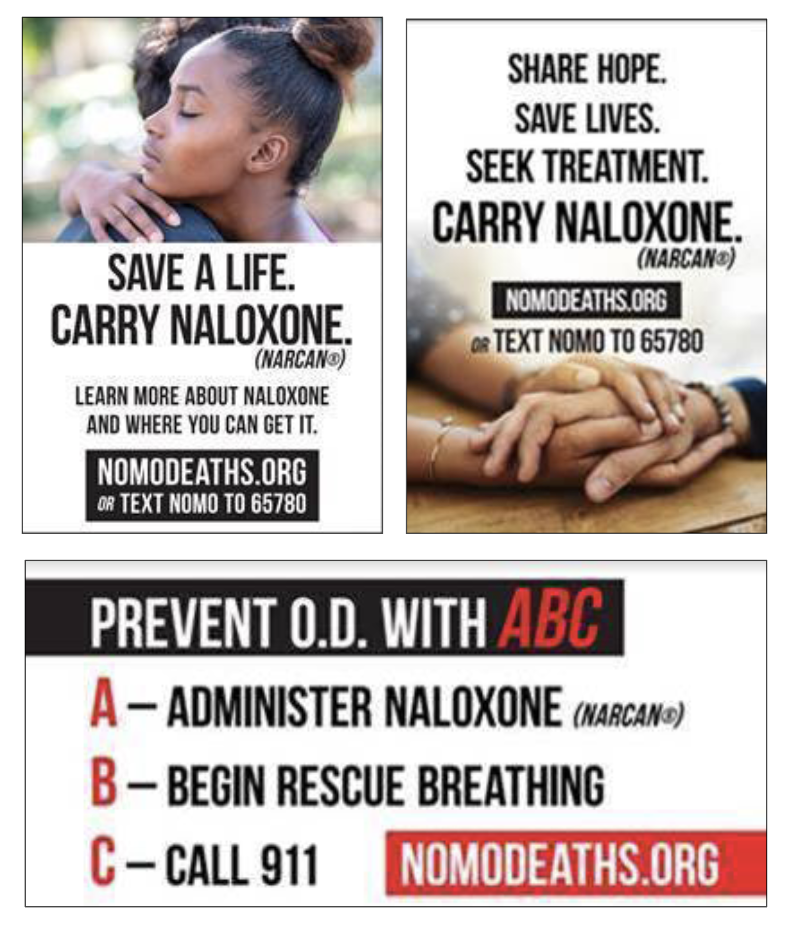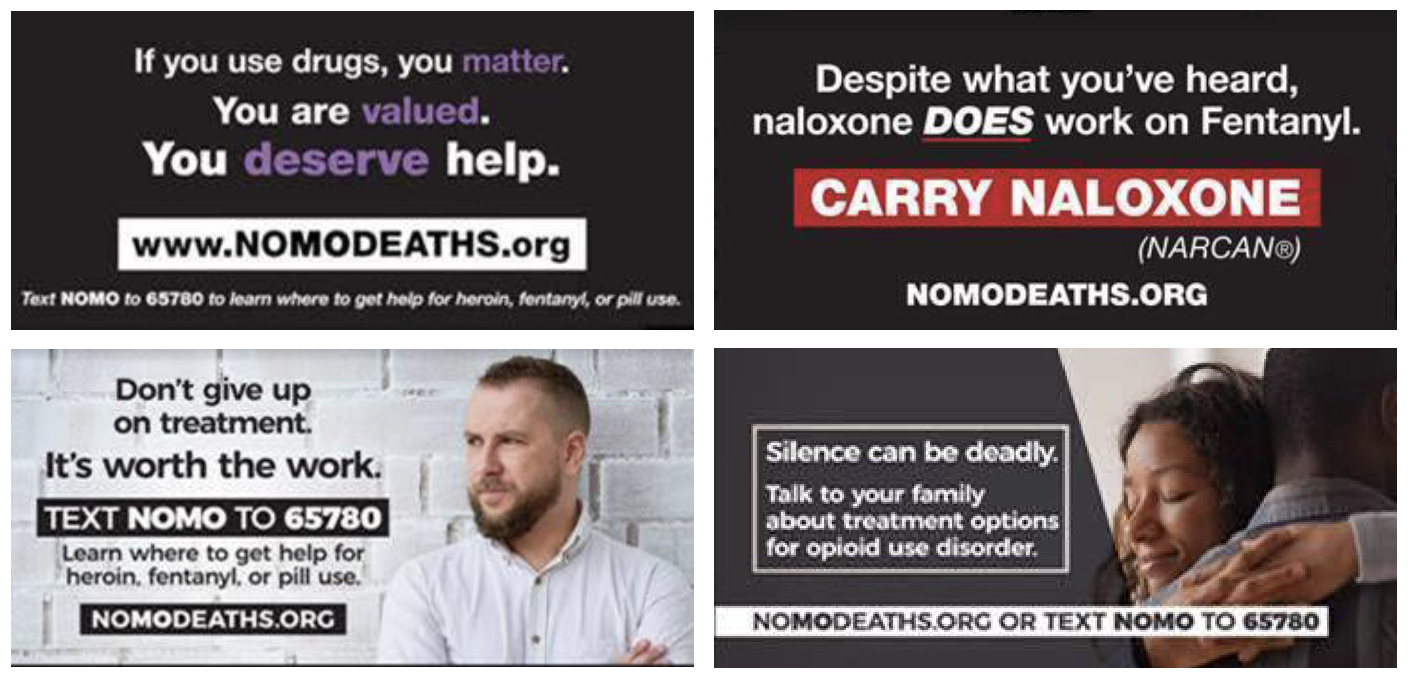Home > No MO Deaths Prevention Media Campaign

The No MO Deaths media project is a public education campaign that has been disseminated across the state of Missouri via radio spots, billboards, posters and signage in public transportation systems. By collaborating with several community partners, conducting focus groups and working with a marketing agency, the team behind No MO Deaths was able to create powerful messaging taken directly from those with opioid use disorders and their loved ones.
The Missouri Opioid State Targeted Response (STR) and Missouri State Opioid Response (SOR) projects expand access to integrated prevention, treatment, recovery support, and harm reduction services for individuals with opioid use disorder (OUD) throughout the state. The State of Missouri Department of Mental Health (MDMH) is leading the project, with administration, implementation, and evaluation activities provided by the University of Missouri, St. Louis - Missouri Institute of Mental Health (UMSL-MIMH) – as well as healthcare agencies, academic institutions, people with lived experience with addiction, and other content experts from around the state.
The PTTC Network Coordinating Office conducted an interview with some of the key team members who worked on the campaign:
Angie Stuckenschneider, Director of Prevention and Mental Health Promotion at MDMH
Lauren Green, B.S., Overdose Prevention Coordinator
Rachel Winograd, Ph.D, Project Director
Philip Horn, MSW, MPH, Project Manager
AS: When we put the budget together for the State Opioid Response grant, we had planned to do a public education piece as part of our comprehensive approach to address the opioid epidemic. So the first step really was to put aside some funding for it and then build a plan out.
RW: As you may know, the opioid overdose crisis is covered so heavily in national, state and local media. We were getting questions relatively frequently, like, ‘what is Missouri doing about this and is Missouri doing anything?’ I think a couple key people in some key meetings may have asked that same question. And it became clear at DMH [Department of Mental Health] that we need to put that information out there and make what we're doing as a state to tackle this more visible to the public. We wanted to do a campaign like this to tell people how to access help.

RW: Yes, other states have done similar media approaches, and we certainly looked at other examples when we crafted this. Public messaging around drug use is nothing new. We had baskets of examples from all around the country. And there were certainly ones we gravitated toward more than others — I would say less so the ‘don't do drugs’ or ‘opioids can kill you’ or other scare tactics. We looked more toward the fact-based, educational campaigns and also ones that just had general motivational or compassionate messages.
PH: We collaborated with the Department of Mental Health for research, as well as with Hubbard Interactive, which is a company that has a lot of experience with public-health marketing across Missouri.
It was important for us to hear from the people that these messages were going to reach first and foremost. We worked with two different focus groups in the St. Louis metropolitan area at Better Family Life and the Missouri Network for Opiate Reform and Recovery. For the focus groups, we had people who use drugs and their loved ones come in and discuss what kind of messages they wanted to see in their community. We asked questions like “What kind of help would you need? What kind of messages would you like to see?’
In the end, our campaign was basically a hybrid of these focus group findings and best practices for the messages that we wanted to convey. We wanted compassionate messaging that encouraged people and their loved ones to reach out to treatment centers and recovery centers for support.
LG: The focus groups really helped us with messaging. We had some general ideas on what we wanted to put out there like medication for addiction treatment, information about naloxone, etc. But going into the focus groups, we quickly realized how important it was also going to be to destigmatize people who use drugs and addiction, and correct some of the misinformation that was out there. I think it was really cool that we were able to take the words and experiences of those in active addiction, and use that in this campaign to not only get resources out, but also bring their voice to light. I think that's something that was a little bit different from what I've been able to see in any other cities.

LG: I hope that the people who were in those focus groups will see the messages and feel valued and empowered. I hope that the campaign also spreads a little compassion. For me personally, I think it’s really hard to see some of the things that are on social media platforms, where people have no compassion for people who use drugs. I hope that this campaign can lead to people having a little bit more understanding or encourage them to reach out and get educated about it.
RW: I hope the campaign provides more public education around opioid use disorder. The messages that aren't necessarily as compassion-focused are very practical — for example, ‘how to use Naloxone,’ where you can learn a fact in an instant that you didn't know before. And that has the potential to empower you to save someone's life. So hopefully, this campaign is effective in getting evidence-based information out in the community in an efficient way.
PH: It's always challenging to track the success or progress of public service announcements. A couple of things I can speak to, however, is that our website traffic has expanded. We've had a lot more hits on our website, which means people are actually seeking resources. And second, we can track impressions and clicks on our social media accounts. We can look at how many people are seeing it online, clicking on the information and following through to the website.
Do you have any advice you'd want to give other organizations that would be interested in doing a campaign like this?
PH: Have a lot of input on the front end. You really don't want to get to the end of a process like this and be like, ‘okay, we created these messages — now let's ask for people's opinions about the people that are most affected.’ You don’t want to have to go back to the drawing board, waste money, waste time, etc.
AS: Work with a professional marketing advertising agency instead of trying to do it yourself. Especially when you have several different community partners working on it together, having an agency off to the side who's not necessarily involved in our day-to-day to help keep us in check and make sure we’re meeting all the different marketing and advertising bars.
AS: It was a lot of work. But I think the takeaway is, it's worth it. These are some important messages; it's an important campaign. It was definitely worth it.
LG: For me, the end product of being able to see the billboards and messages out there that elevated the voices of individuals with opioid use disorder and their loved ones was the most impactful. This project was another reminder that involving those directly impacted in the work we are doing is critical.
To learn more about the No MO Deaths project, visit: https://www.nomodeaths.org/